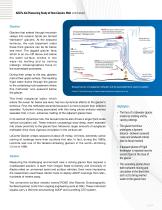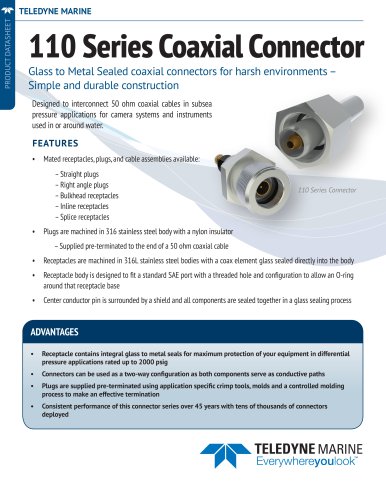
Catalog excerpts

Overview Instruments Global concern about rising sea levels has thrust increasing loss of glaciers and ice sheets into public attention. A key uncertainty in projections of sea level rise is the rate of ice loss at the seaward margin of glaciers. The glaciers of Greenland and Alaska that reach the sea have therefore received increased scientific notice. Yet the ways in which warm ocean water interacts with and erodes the face of these glaciers have been largely unobserved. Operating near an ice cliff that is actively calving icebergs—above and below the water line—is both difficult and dangerous. Icebergs, sized as big as football fields, can shoot to the surface at 300 m from the glacier’s face. A variety of ocean processes, ranging from mixing to circulation, are stimulated at a glacier’s terminus. As well as local dynamics at the ice/ocean boundary, the melting is influenced by remote factors. Examples include weather conditions farther inland and deep-water temperatures farther seaward. In the summer of 2018, a team of scientists from Oregon State University and University of Alaska deployed an extensive and innovative observational program to study ocean processes at the face of LeConte Glacier in Southeast Alaska. Teledyne RDI ADCPs were installed on moored and moving platforms, and so played two different roles in the study. Upward-looking ADCPs were fitted to several moorings that had a variety of purposes, including recording ascending motions near the face of the glacier and measuring deep horizontal currents. These currents carry warm seawater toward the glacier. In a second role, ADCPs were mounted on remotely controlled kayaks developed by OSU. These unmanned vehicles were used to deploy moorings in dangerous yet critical locations adjacent to the glacier’s calving ice cliff. As well, the vehicles performed spatial surveys around the fjord. LeConte Glacier, one of the most active glaciers in Southeast Alaska. Credit: J. Nash (Oregon State University) Products Sentinel V & Workhorse ADCPs Application Study melting of ocean/glacier interface Organizations Oregon State University (OSU) University of Alaska University of Oregon Sponsors US National Science Foundation (NSF) National Geographic Society Principals Profs. Jonathan Nash & Erin Pettit Data Collection Date Summer, 2018 Location LeConte Glacier, SE Alaska
Open the catalog to page 1
Situation Glaciers that extend through mountain valleys into oceanic fjords are termed “tidewater” glaciers. At the seaward terminus, the rock basement under these thick glaciers can be far below sea level. The jagged glacier face, which is an ice cliff above and below the water surface, erodes in two ways—by melting and by calving icebergs. Oceanographers focus on the submerged processes. During their creep to the sea, glaciers melt at their upper surface. The resulting frigid water drains through the glacier to the underlying rock basement where this meltwater runs seaward below the...
Open the catalog to page 2
The target of the project was to measure the plume of subglacial discharge ascending the face of LeConte Glacier. The vertical beam and remote measuring capability of an uplooking near-bed Sentinel V ADCP were well suited to this need—especially with some prospect of icebergs shooting upward and colliding with objects in the measurement region. The researchers used a creative strategy to place the ADCP mooring near the face of the glacier and beneath the upwelling plume. This type of mooring named ABLE (acoustic bottom landing explorer) comes from ongoing engineering work at OSU. Other...
Open the catalog to page 3
ADCP time series when a “shooting” iceberg calved from LeConte Glacier. Depth (m), Time (h:min), Speeds to ±1 m/s with RED positive, BLUE negative. Credit: J. Nash (Oregon State University) https://goo.gl/5FodjB Right: ADCP transects showing fjord circulation near LeConte Glacier. Credit: J. Nash et al., 2017 (Oregon State University). https://goo.gl/SXZkYT Results The team deployed ADCP moorings to observe water motions associated with melting of the glacier face. One ADCP happened to record a calving event of a submerged iceberg in which a huge piece of ice separated at the base of the...
Open the catalog to page 4All Teledyne D.G.O'Brien catalogs and brochures
-
Single Pin Horizontal EFS
2 Pages
-
Omicron
5 Pages
-
Nautilus WM10-250
2 Pages
-
Nautilus™ WM1.7-60
2 Pages
-
FACT
2 Pages
-
Compact FACT
2 Pages
-
100 Series Connector
2 Pages
-
110 Series Coaxial Connector
2 Pages
-
107 Series Connector
1 Pages
Archived catalogs
-
Sentinel V
4 Pages
-
Pinnacle 45
2 Pages
-
Teledyne Marine Vehicles
24 Pages
-
Saturn INS
2 Pages
-
LED-V-Series
2 Pages
-
UTS-9400
2 Pages
-
RiverPro ADCP
2 Pages
-
RiverRay ADCP
2 Pages
-
DGO 108 Series Connectors
2 Pages
-
DGO Product Selection Guide
5 Pages
-
ODI FACT
2 Pages
-
ODI Nautilus WM10-250
2 Pages
-
DGO Standard Products Catalog
25 Pages
-
ODI Extended Ethernet
1 Pages
-
ODI Hybrid FACT
1 Pages
-
PDM QuickCure Molding System
1 Pages
-
Storm Cable Capabilities
1 Pages
-
Penetrators and Feedthroughs
1 Pages
-
Product catalog:DGOstdcat
34 Pages










































